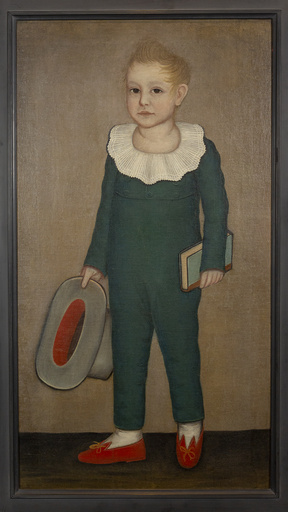NEW YORK (AP) — What does “home” mean? Different things to all of us, of course.
A place of love, for some. One fraught with trouble, for others. An elusive concept for too many.
“Home isn’t always a place of comfort. Nor is it always a location, or a place. Home can be a state of mind,” says Brooke Wyatt, curator of a show at the American Folk Art Museum called “Somewhere to Roost.”
The collection of 60 pieces explores artists’ conceptions of home in paintings, illustrations, folk art objects, collages, blanket chests, quilts and family photographs.
Home as a nest…
The exhibition’s title piece, “‘Birds Gotta Have Somewhere to Roost” by Thornton Dial Sr., is a collage of weathered wood, burlap, carpet and tin. At first glance, it’s a scramble of tossed-away scraps. But consider the title and you imagine something else: birds gathering the bits to make a nest. Dial’s work, including many such assemblages of found materials, are in museum collections around the U.S.
Birds are depicted in a pen-and ink drawing made in the 1800s by V.H. Furnier, an artist and penmanship teacher in Indiana, Pennsylvania. It includes the words “Home Sweet Home,” and above it an avian pair, one of them carrying a sprig with the words “Spare the Birds.”
New Englander Joseph E. Clapp’s beautiful birdcage is another standout. Made of Peruvian mahogany and whalebone with petite brass pins, it’s a marvel of construction. Clapp was a master mariner who worked on whale boats in the 1850s. When he retired, he created a bird sanctuary in Peru. He finally returned to Nantucket, where he was often seen strolling the streets with his pets in their cages.
…or as a prison
A drawing called “Devil House” conveys what it means when home is a literal prison cell. Incarcerated in a Huntsville, Alabama, prison, Frank Albert Jones started drawing with the red and blue pencil stubs discarded by inmate bookkeepers. A recurring theme is enclosed rooms surrounded by jagged wiry barbs he called “devil’s horns,” with grinning spirits. He frequently includes a clock; for many years, his cell faced the penitentiary’s clock tower.
Jones’ signature on “Devil House” includes his neatly printed prison number, 11451.
A place to create
Clementine Hunter grew up on Louisiana plantation and became an acclaimed self-taught artist. Starting in her 50s, she created a visual history of everyday life there — from laundry days to weekend parties — as she remembered it in the early 1900s. Two of her untitled works are in the exhibition; one shows people gathering at an outdoor funeral, while the other depicts a courtroom scene.
Another painting in the exhibit is of Roberta Flack, by the Jamaican artist Kapo, whose given name was Mallica Reynolds. Flack and Reynolds had become close in the 1970s after she saw his works on display in a hotel in Jamaica, and Flack set up a foundation for the artist so he could concentrate on his work without worrying about finances.
When Kapo’s house burned down, it was Flack who helped him rebuild, and her support allowed him to stay in his hometown and continue his art. It was one of many obstacles that he overcame, said his daughter, Christine Reynolds, who came to see the exhibition.
“Seeing his painting on view in `Somewhere to Roost’ is yet another signal that his work made it through,” she said. “I feel pride, vindication and joy, and I only wish I had him at the museum next to me so that I could watch his reaction to seeing it.”
A fragile toehold
A photograph by Margaret Morton entitled “Mr. Lee’s Home” shows a makeshift dwelling that was part of a lower Manhattan homeless encampment in the 1980s and early ’90s. It and some other shelters were destroyed by an arsonist in 1992; resident Yi-Po Lee died in the fire.
Morton chronicled the camp’s residents in her series “Fragile Dwelling.”
“These impoverished habitats are as diverse as the people who build them, and they bear witness to the profound human need to create a sense of place, no matter how extreme one’s circumstances,” she wrote.
Domestic tranquility
In one painting, a young boy is wearing some snazzy red slippers and a blue romper. He’s got a big book in one hand and an even bigger hat in the other. You get the impression he’s stopped only momentarily before running off to play in his room.
“Portrait of Frederick A. Gale” was painted by Ammi Phillips in 1815 and is one museum director Jason Busch’s favorite pieces in the collection. It stands out, he said “because it’s representative of an art genre that, up till then, had been the purview of society’s upper crust.
“But around this time, more middle-class families were financially able to commission portraits.”
Frederick wears a big smile and clothes that are less fussy and more childlike than those of kids in more traditional portraits.
Built from bottle caps
Clarence and Grace Woolsey of Reinbeck, Iowa, had fun creating things out of the boxes of bottle caps that everyone had in the 1960s, before recycling programs became widespread. They strung together dozens of caps with baling wire, forming them into animals, objects and structures. The Museum has one of the small houses from the collection; the red-painted, tightly-packed caps with wavy edges resemble shingles, and the homey vibe epitomizes found-object craft art at its best.
—-
“Somewhere to Roost” runs until May 25, 2025, at the American Folk Art Museum in New York City.
This website uses cookies so that we can provide you with the best user experience possible. Cookie information is stored in your browser and performs functions such as recognising you when you return to our website and helping our team to understand which sections of the website you find most interesting and useful.
